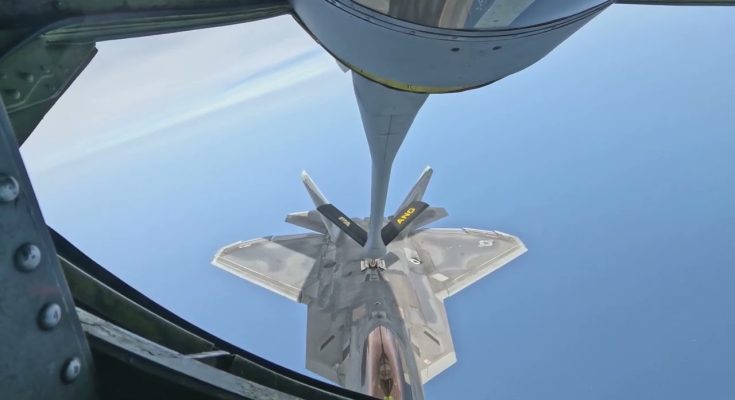Eight F-22 Raptors Air Refuel Over the Atlantic with a KC-135 Tanker
In a stunning demonstration of aerial precision and power projection, eight U.S. Air Force F-22 Raptor fighter jets successfully conducted an in-flight refueling operation over the Atlantic Ocean with a KC-135 Stratotanker. This mission, executed flawlessly at high altitude, highlights the Air Force’s global reach capabilities and the critical role of aerial refueling in enabling long-range operations for advanced stealth aircraft.
The F-22 Raptor, developed by Lockheed Martin, is the most advanced fifth-generation air superiority fighter in the world. Its combination of stealth, speed, agility, and situational awareness makes it a cornerstone of U.S. air dominance. However, one limitation of any fighter jet, regardless of its technology, is fuel capacity. In-flight refueling allows fighters like the F-22 to remain airborne for extended periods, traverse vast distances, and project power far beyond their home bases.
The KC-135 Stratotanker, developed by Boeing and first introduced in the 1950s, continues to serve as a vital link in the chain of global air operations. Though decades old, the KC-135 has been continually updated and modernized. It is capable of refueling a wide range of aircraft mid-air using a boom system. In this mission, the KC-135 provided fuel to all eight F-22s while flying over international waters in the Atlantic, coordinating timing and positioning with surgical accuracy.
This type of mission requires rigorous coordination, planning, and communication between flight crews. The F-22 pilots must approach the tanker with extreme precision, often flying just a few feet below and behind the aircraft while matching its speed and heading. The boom operator aboard the KC-135 must then guide the refueling boom into the F-22’s receptacle, often while both aircraft are traveling at speeds exceeding 400 knots and at altitudes above 25,000 feet.
The successful completion of this operation not only extends the F-22’s operational range but also sends a clear strategic message. Aerial refueling missions over the Atlantic are typically part of larger training exercises, deployments, or strategic deterrence efforts. These missions ensure that U.S. fighter aircraft can deploy rapidly to allied nations, respond to crises, or participate in joint operations anywhere around the globe.
In addition to the strategic implications, these missions serve as critical training opportunities for both fighter pilots and tanker crews. Familiarity with air refueling procedures in various conditions, including over oceanic expanses and in adverse weather, is vital to mission readiness.
As geopolitical tensions continue to evolve, the ability to execute seamless aerial refueling operations remains a cornerstone of U.S. airpower. The image of eight F-22 Raptors soaring across the Atlantic, linked momentarily to their flying gas station, is more than just a technical achievement—it is a symbol of sustained readiness, reach, and dominance in the skies.



